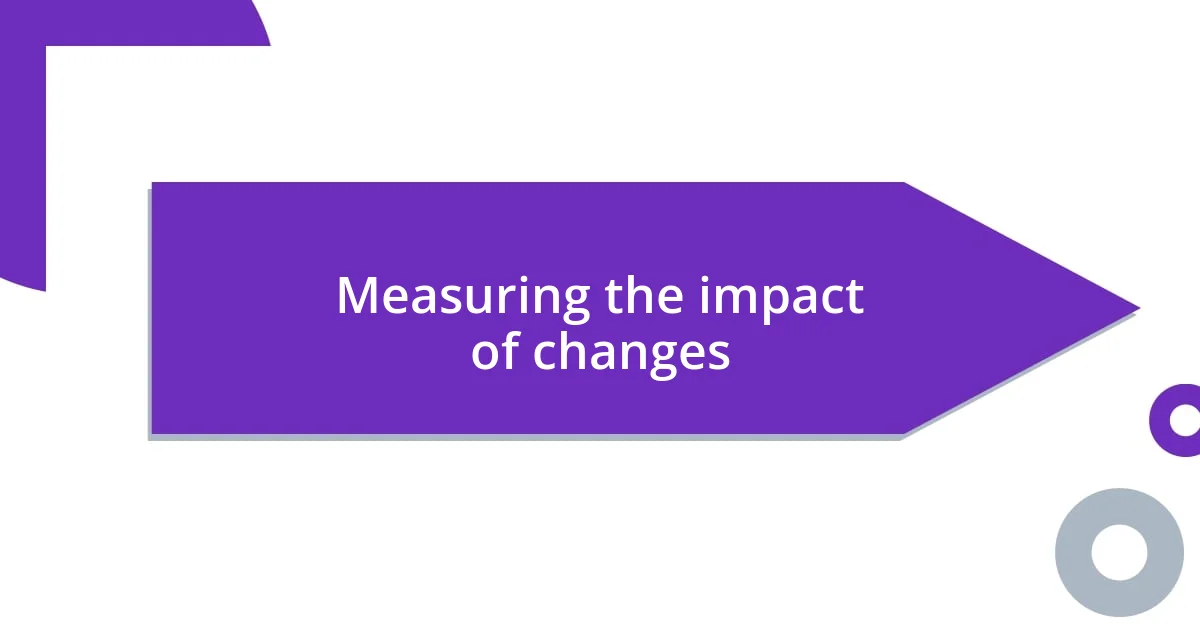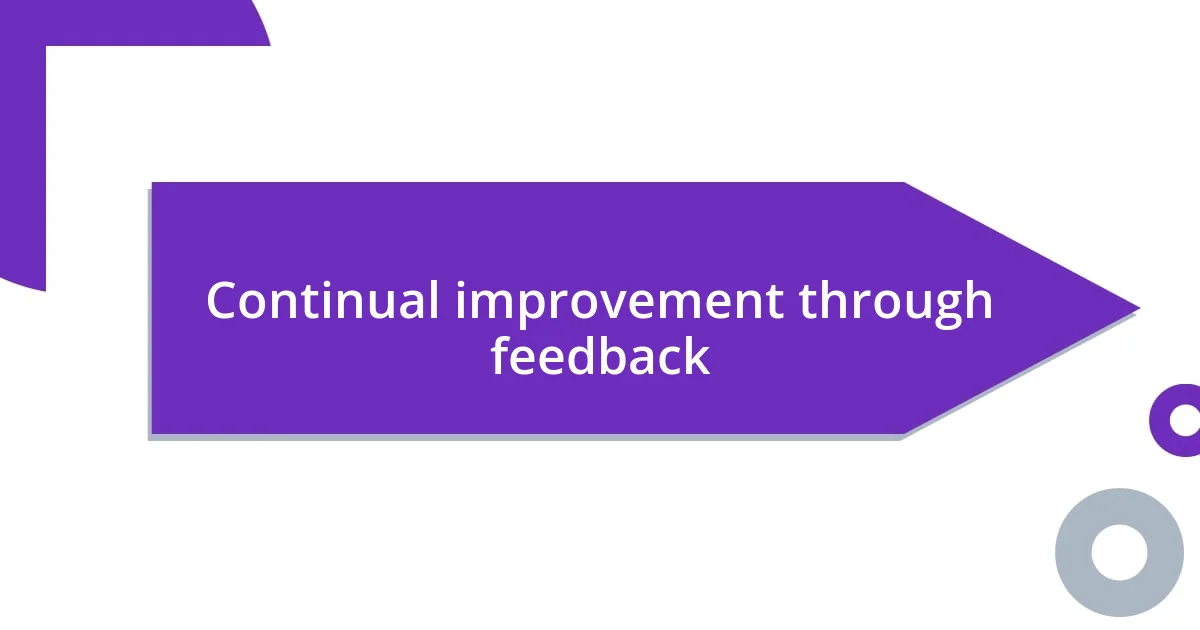Key takeaways:
- Feedback is essential for character depth, as it uncovers aspects and motivations that the writer may overlook, leading to richer narratives.
- Utilizing diverse feedback sources—peer reviews, reader insights, and professional critiques—enhances the character development process and fosters relatability.
- Embracing and analyzing feedback promotes continual improvement in writing, encouraging personal growth and resilience in storytelling.

Understanding the importance of feedback
Feedback is the lifeblood of character development. When I first started writing, I was amazed by how a simple critique could transform a flat character into someone readers genuinely cared about. Have you ever felt that thrill when someone points out a nugget of insight you hadn’t even considered?
I remember one particular instance when a friend read my draft and mentioned that one of my characters felt one-dimensional. At first, I was defensive—after all, I’d put so much effort into crafting them! But upon reflecting, I realized they were right. It was tough to swallow, but that feedback ignited a spark that pushed me to dig deeper into that character’s backstory and motivations.
This experience taught me that feedback isn’t just about correcting mistakes; it’s about expanding perspectives. It’s about uncovering layers that you, as the writer, might overlook. Don’t you find it fascinating how others can illuminate aspects of your work that you may be blind to? Embracing feedback allows for growth, both as a writer and as a creator, ultimately leading to characters that resonate on a deeper level.

Types of feedback to consider
When seeking feedback, I find it crucial to explore various types, each offering unique insights. Peer reviews often come from fellow writers who understand the craft. Their critiques can be incredibly valuable, as they may see nuances that I miss. I recall a time when a writing group helped me understand the emotional arc of my character through their own connections. It was eye-opening to hear how my character’s struggles mirrored their experiences, leading me to deepen the character’s emotional landscape.
Another type of feedback to consider is reader feedback, which comes from people outside the writing community. This was particularly enlightening when I shared my work with non-writers who had no preconceived notions about storytelling. Once, a beta reader shared how a character’s decision felt unrealistic to them, prompting me to examine the motivations behind that choice more carefully. It showed me that while writers can get lost in their own worlds, the reader’s perspective can ground a character in believability.
Lastly, professional critiques can offer a different caliber of feedback with industry insights. I’m often surprised by how these professionals point out trends and reader expectations that I might not be aware of as an emerging writer. I remember sending a manuscript to an editor who highlighted a character’s lack of agency. This critique pushed me to rethink character choices and agency, enriching the narrative in ways I couldn’t have anticipated.
| Type of Feedback | Characteristics |
|---|---|
| Peer Review | Insightful critiques from fellow writers |
| Reader Feedback | Perspectives from non-writers |
| Professional Critiques | Industry insights and trends |

Gathering feedback from diverse sources
Gathering feedback from a variety of sources can be a game changer for character depth. I’ve found that when I reach out to diverse individuals, their unique perspectives help me unearth dimensions of my characters I hadn’t considered before. For instance, after sharing a draft with a close family member, they pointed out characteristics that reflected their own experiences, which added an unexpected authenticity to my character. That moment made me realize how personal connections can bring a whole new layer to storytelling.
When I actively seek feedback, I make a point to consider the following sources:
- Writing Groups: Peers provide insights into the craft and emotional layers.
- Family & Friends: Their familiarity allows for honest reactions and personal connections.
- Online Forums: Diverse opinions can highlight blind spots in my character development.
- Beta Readers: Non-writers can offer fresh perspectives that ground my characters in reality.
- Professional Editors: Their industry knowledge can illuminate trends and expectations I might miss.
By engaging with these varied voices, I can cultivate richer, more relatable characters that resonate deeply with my audience.

Analyzing feedback for character depth
Analyzing feedback is like peeling back layers of an onion; each reveal can significantly enhance your character’s depth. I often find myself reflecting on a piece of feedback that suggested my character seemed somewhat one-dimensional. At first, I felt defensive, but upon deeper analysis, I realized there was merit in the observation. By examining the character’s backstory and relationships more closely, I discovered hidden motivations that really brought them to life.
I also remember a time when a friend pointed out that a character’s reaction to a crisis felt understated. It made me wonder: how do we truly depict emotional responses? This led me to explore moments of vulnerability, ensuring my character reacted in a way that felt authentic and relatable. Ultimately, that conversation pushed me to dive deeper into their psyche, crafting a more complex emotional landscape.
Interestingly, I once shared a draft with a writing mentor whose feedback shook me to my core. They questioned whether my character’s choices felt motivated or arbitrary. This critique made me pause and assess every plot point—were my characters acting or merely reacting? By analyzing the feedback, I managed to weave in layers of choice and consequence that not only deepened character motivation but enriched the entire narrative arc.

Implementing feedback effectively
Implementing feedback effectively is essential for transforming insights into actionable changes. I remember receiving a critique that suggested my protagonist lacked agency in the story. At first, it stung a bit because I believed I’d created a strong character. But instead of dismissing the comment, I took a step back. I started asking myself, “What decisions does my character make, and what drives those decisions?” This reflection led me to revise key scenes, ensuring that my character’s choices were not only visible but empowering.
When I receive feedback, I also try to categorize it based on its intent—whether it’s emotional impact, plot coherence, or character development. On one occasion, a writing buddy pointed out that my antagonist’s motivations were murky. It intrigued me: what makes a villain memorable? I delved into their backstory and created moments that revealed their fears and desires. The result? A more nuanced character who felt relatable, even in their darkness.
I’ve learned to celebrate the discomfort of feedback, recognizing it as a vital part of growth. There was a time when I felt overwhelmed by conflicting opinions from my writing group. Instead of throwing up my hands in frustration, I created a list of recurring themes among the feedback. This created clarity amidst the noise. By focusing on the common threads, I could address fundamental issues without getting lost. Ultimately, this process not only enhanced my characters but also taught me to embrace feedback as a collaborative tool in my writing journey.

Measuring the impact of changes
Measuring the impact of changes is a fascinating journey where I often find myself reflecting on the transformation of my characters. One time, after implementing feedback to add more internal conflict to a character’s dilemma, I decided to test it by sharing the revised draft with a different group of readers. Their reactions were telling; they felt more invested in the character’s journey. This reinforced how critical it is to assess whether changes resonate with the audience emotionally.
After restructuring a character’s motivations based on feedback, I took a step back to analyze the plot’s arc. I asked myself, “Do these adjustments make them feel more authentic, or do they risk losing the essence I was aiming for?” The impact was profound—readers not only understood my character’s decisions better but also connected with them on a personal level. Witnessing their evolving perceptions illuminated the ripple effect that thoughtful changes can create.
I’ve learned to keep a feedback journal where I track the results of alterations over time. It might seem tedious, but the insights gained are invaluable. For instance, after enhancing a supporting character with richer backstory details, I noted a marked increase in reader engagement in subsequent discussions. As I looked back, I realized that measuring impact isn’t just about quantitative feedback—it’s also about nurturing a deeper emotional resonance with my audience. How do you measure character depth? It’s a delicate balance of feedback, revisions, and the emotional journey that leads to more engaging storytelling.

Continual improvement through feedback
Feedback serves as a catalyst for continual improvement, especially in character development. I recall a workshop I attended where one participant shared that she felt disconnected from my character’s journey. It was a tough pill to swallow, but it sparked something within me. I wondered, “How can I ensure readers truly feel my character’s struggles?” That question led me to deepen my character’s relationships and motivations, weaving in more realistic emotions that connected with the audience on a fundamental level.
Throughout my writing journey, I’ve come to see feedback as a treasure map. Each critique reveals hidden areas I might have overlooked. For instance, after receiving comments that my character’s growth felt rushed, I took the time to explore their backstory more thoroughly. I reminisced about my own growth journeys, realizing that true transformation doesn’t happen overnight. This reflection not only enriched my character’s arc but also made it more relatable for readers, emphasizing that their growth mirrors our own life experiences.
Additionally, I’ve learned that embracing feedback doesn’t just improve my writing; it builds resilience. There was a time when I felt crushed after receiving negative critiques from a trusted reader. Instead of shying away from their insights, I leaned in and asked for more specifics. “What exactly felt off?” It turned out, they had valuable perspectives that opened my eyes to my blind spots. That experience taught me that vulnerability in accepting feedback invites deeper connections not only with my characters but also with my readers—something that can be a transformative force in storytelling.














